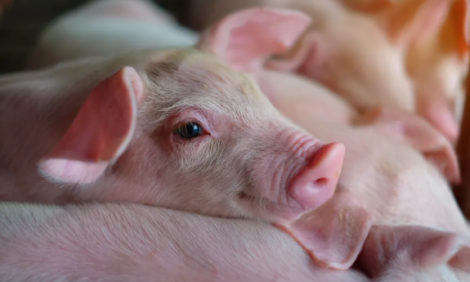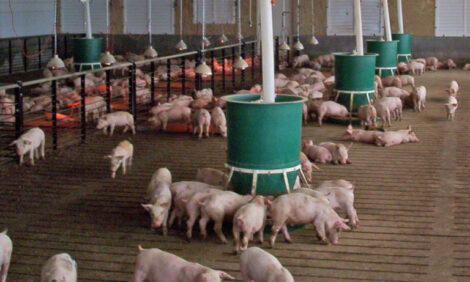



Danish producers network for profit
By Bernard Peet - Danish pig producers are admired throughout the world for making a success of cooperation. They own the three giant processing companies and through their organization Danske Slagterier (DS) control virtually all aspects of the industry, from research and breeding programs to marketing and political representation. Formidable competitors
Formidable competitorsDespite relatively high production costs, they are a formidable competitor to lower cost producers such as Canada in export markets. However, until recently, cooperation at farm level has been minimal.
Economic pressures have reduced the number of farms with pigs by 50% every 10 years so that now, about 4000 producers account for 70% of the 22.5 million pigs slaughtered each year. This gradual attrition has obviously left the most efficient producers with larger herds, and the logical thing would be for this process to continue in future. However, the constraints of environmental legislation mean that, for many producers, expansion is out of the question.
Farm size limits
An individual may only own a maximum of three 250 sow, farrow-to-finish units. Based on Animal Units (AUs), which equate to 1 sow and progeny up to a 100kg slaughter weight, a farm could have about 800 sows with progeny to 30kg, or 1150 sows with progeny moved off-site at weaning (7kg).
Networked production
The problem is, that a producer with an 1150 sow and piglet producing unit cannot own all the nursery and finishing pigs. Therefore, in order to exploit the economies of scale from larger units, producers are now rapidly moving to networked production based on 2 or 3-site systems. Typically one person owns the sows and often the nursery, and several other people, sometimes working with pigs on a part time basis, own the finishing barns.
Many benefits
Dr Bjarne Pedersen of DS has been working on the development of these networks and says that there are many benefits. "Pig health, and consequently performance, is significantly improved by moving to multi-site production," he says. "Producers also get a better financial return on their time because they are more specialized and focussed." Typically the batch size of pigs is 4-500, but may be up to 1000 where batch farrowing every 2-3 weeks is carried out.
"Producers with farrow-to-finish units tend to convert these to breeding-only units, and build a new nursery on a separate site," says Dr Pedersen. "The move to multi-site is very rapid and we estimate that by 2005 such systems will account for 40% of production, whereas 4 years ago it was virtually nothing." He reckons that by 2010, 80% of pigs will be produced in multi-site systems
Communication is key
In order for the network system to work well, good communication is essential. First, batch sizes must be matched across the farms involved and long term agreements set up. Then, when the system is running, regular meetings are needed to discuss numbers, quality of pigs, health, feeding and pig movements.
The price of 7kg and 30kg pigs is related to cost of production, with the margin over the slaughter price shared equitably according to the level of investment involved. "Networking requires not only close collaboration between producers, but openness and a willingness to work together to reduce production costs," points out Bjarne Pedersen.
"We are increasingly seeing producers purchasing feed and other inputs together, using the same vet or production adviser and planning any expansion or changes together - in fact almost operating as one single business."
Asger Krogsgaard is an enthusiastic networker with 650 sows, farrowing 53 sows every second week to give a batch size of around 550 piglets. When he expanded his sow herd, from 450 sows, producing 30kg weaners, he built a new nursery barn on a site about 1km away, with 4 rooms or 8 weeks production. He networks with five other producers who have between 500 and 2000 finisher places and are 1 to 30km away from the nursery site.
Expansion
Asger plans to expand shortly to 1100 sows, farrowing weekly, which will maintain the same batch size of 53 litters per batch. At the same time he will add four more rooms to the nursery, again maintaining batch size for all in/all out management. Some of the finishing producers will also take the opportunity to enlarge their facilities at the same time. "We work very closely together on managing the whole system," says Asger. "If a health problem occurs, for example, it has implications for everyone involved and decisions must be taken jointly."
Outstanding performance
Performance in the system is outstanding, with the breeding herd producing 26.3 pigs per sow and nursery pigs from 7 to 26kg growing at 445g/day with 1% mortality. Finishers average over 950g/day from 26-103kg.
Although the move to networked production was stimulated, at least partly, by environmental constraints, the advantages are wide-reaching. Bjarne Pedersen estimates the total production cost savings to be 10-15% compared to continuous flow farrow-to-finish units, a large part of which is due to the health benefits.
By working together to add value at all stages of production and also to the processor Danish pig farmers will continue to reduce costs, improve quality and maintain their competitiveness in future.
Source: Bernard Peet, thePigSite Consultant - October, 2001
(also published in Western Hog Journal, Summer 2001)









